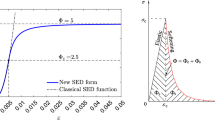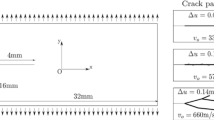Abstract
We present a new scalar damage model for dynamic brittle fracture. In contrast to existing damage theories, the internal damage variable is alternatively derived based on energy limiter theory, directly tightening to its physical meaning. Finite element implementation for the developed approach at small strain towards localized brittle failure is given. We integrate the energy decomposition into the theory to eliminate nonphysical damaged phenomenon when cracks develop in compression domain, while the crack band theory is employed to treat mesh sensitivity. As a result, the current model does not involve any length scale parameter, and therefore nor diffusive equation of damage evolution characterizing the degradation of material stiffness is required. Two simple methods for estimating crack-tip velocity and dissipated energy are provided. Discrete forms of governing equation are solved by a simple staggered scheme in an effective manner. Several numerical examples for dynamic brittle fracture including crack branching are studied.
























Similar content being viewed by others
References
Cox BN, Gao H, Gross D, Rittel D (2005) Modern topics and challenges in dynamic fracture. J Mech Phys Solids 53:565–596
Xu X-P, Needleman A (1994) Numerical simulations of fast crack growth in brittle solids. J Mech Phys Solids 42:1397–1434
Krugger R (2004) Virtual crack closure technique: history, approach, and applications. Appl Mech Rev 57:109–143
Zhang X, Bui TQ (2015) A fictitious crack XFEM with two new solution algorithms for cohesive crack growth modeling in concrete structures. Eng Comput 32(2):473–497
Bažant ZP, Oh BH (1983) Crack band theory for fracture of concrete. Mater Struct 16:155–177
Rots JG, Nauta P, Kuster GMA, Blaauwendraad J Smeared crack approach and fracture localization in concrete. HERON 30(1)
Peerlings RHJ, de Borst R, Brekelmans WAM, de Vree JHP (1996) Gradient enhanced damage for quasi-brittle materials. Int J Numer Meth Eng 39(19):3391–3403
Francfort GA, Marigo J-J (1998) Revisiting brittle fracture as an energy minimization problem. J Mech Phys Solids 46(8):1319–1342
Nguyen THA, Bui TQ, Hirose S (2018) Smoothing gradient damage model with evolving anisotropic nonlocal interactions tailored to low-order finite elements. Comput Methods Appl Mech Eng 328:498–541
Miehe C, Hofacker M, Welschinger F (2010) A phase field model for rate-independent crack propagation: Robust algorithmic implementation based on operator splits. Comput Methods Appl Mech Eng 199(45):2765–2778
Kachanov L (1958) Time of the rupture process under creep condition. Izv Akad Nauk SSSR Otdelenie Tekhn Nauk 8:26–31
Gurson A (1977) Continuum theory of ductile rupture by void nucleation and growth - part i: yield criteria and flow rule for porous media. J Eng Mater Technol 99:2–15
Chaboche J (1981) Continuum damage mechanics - a tool to describe phenomena before crack initiation. Nucl Eng Des 64:233–247
Chaboche J (1984) Continuum damage mechanics: Part ii - damage growth, crack initiation, and crack growth. J Appl Mech 55:65–72
Lemaitre J (1986) Local approach of fracture. Eng Fract Mech 25:523–537
Pijaudier-Cabot G, Bazant Z, Tabara M (1988) Comparison of various models for strain-softening. Eng Comput 5:141–150
Oliver J (1989) A consistent characteristic length for smeared cracking models. J Eng Mech 28(2):461–474
Jirásek M, Bauer M (2012) Numerical aspects of the crack band approach. Comput Struct 110–111:60–78
Rizzi E, Carol I, Willam K (1995) Localization analysis of elastic degradation with application to scalar damage. J Eng Mech 121:541–554
Kurumatani M, Terada K, Kato J, Kyoya T, Kashiyama K (2016) An isotropic damage model based on fracture mechanics for concrete. Eng Fract Mech 155:49–66
Niazi MS, Wisselink HH, Meinders T (2013) Viscoplastic regularization of local damage models: revisited. Comput Mech 51:203–216
Pijaudier-Cabot G, Bažant ZP (1987) Nonlocal damage theory. J Eng Mech 113(10):1512–1533
Pijaudier-Cabot G, Haidar K, Dube JF (2004) Non-local damage model with evolving internal length. Int J Numer Anal Meth Geomech 28:633–652
Wolff C, Richart N, Molinari J-F (2014) A non-local continuum damage approach to model dynamic crack branching. Int J Numer Meth Eng 101:933–949
Bellis MLD, Wriggers P, Hudobivnik B, Zavarise G (2018) Virtual element formulation for isotropic damage. Finite Elem Anal Des 144:38–48
Vuong CD, Bui TQ, Hirose S (2021) Enhancement of the smoothing gradient damage model with alternative equivalent strain estimation for localization failure. Eng Fract Mech 258:108057
Admed B, Voyiadjis GZ, park T (2021) A nonlocal damage model for concrete with three length scales. Comput Mech 68:461–486
Bui TQ, Hu X (2021) A review of phase-field models, fundamentals and their applications to composite laminates. Eng Fract Mech 248:107705
Bleyer J, Molinari J-F (2017) Microbranching instability in phase-field modelling of dynamic brittle fracture. Appl Phys Lett 110:151903
Aldakheel F, Wriggers P, Miehe C (2018) A modified gurson-type plasticity model at finite strains: formulation, numerical analysis and phase-field coupling. Comput Mech 62:815–833
Geelen RJ, Liu Y, Hu T, Tupek MR, Dolbow JE (2019) A phase-field formulation for dynamic cohesive fracture. Comput Methods Appl Mech Eng 348(10):680–711
Volokh KY (2004) Nonlinear elasticity for modeling fracture of isotropic brittle solids. J Appl Mech 71(1):141–143
Volokh KY (2007) Hyperelasticity with softening for modeling materials failure. J Mech Phys Solids 55(10):2237–2264
Volokh KY (2010) On modeling failure of rubber-like materials. Mech Res Commun 37(8):684–689
Trapper P, Volokh KY (2010) Modeling dynamic failure in rubber. Int J Fract 162:245–253
Borden MJ, Verhoosel CV, Scott MA, Hughes TJ, Landis CM (2012) A phase-field description of dynamic brittle fracture. Comput Methods Appl Mech Eng 217:77–95
Liu G, Li Q, Msekh MA, Zuo Z (2016) Abaqus implementation of monolithic and staggered schemes for quasi-static and dynamic fracture phase-field model. Comput Mater Sci 121:35–47
Song J, Belytschko T (2009) Cracking node method for dynamic fracture with finite elements. Int J Numer Meth Eng 77(33):360–385
Hirmand MR, Papoulia KD (2019) Block coordinate descent energy minimization for dynamic cohesive fracture. Comput Methods Appl Mech Eng 354:663–688
Amor H, Marigo J-J, Maurini C (2009) Regularized formulation of the variational brittle fracture with unilateral contact: numerical experiments. J Mech Phys Solids 57:1209–1229
Ambati M, Gerasimov T, Lorenzis LD (2015) A review on phase-field models of brittle fracture and a new fast hybrid formulation. Comput Mech 55:383–405
Bui TQ, Tran HT (2021) A localized mass-field damage model with energy decomposition: formulation and FE implementation. Comput Methods Appl Mech Eng 387:114134
Bourdin B, Francfort GA, Marigo J-J (2000) Numerical experiments in revisited brittle fracture. J Mech Phys Solids 48(3):797–826
Kuhn C, Muller R (2010) A continuum phase field model for fracture. Eng Fract Mech 99:3625–3634
Dimitrijevic BJ, Hackl K (2008) A method for gradient enhancement of continuum damage models. Tech Mech 28:43–52
Newmark NM (1959) A method of computation for structural dynamics, proceedings of ASCE. J Eng Mech 85:67–94
Kalthoff J, Winkler S (1987) Failure mode transition at high rates of shear loading. Int Conf Impact Load Dyn Behav Mater 1:185–195
Kalthoff J (2000) Modes of dynamic shear failure in solids. Int J Numer Meth Eng 101:1–31
Lloberas-Valls O, Huespe AE, Oliver J, Dias IF (2016) Strain injection techniques in dynamic fracture modeling. Comput Methods Appl Mech Eng 308:499–534
Cusatis G, Rezakhani R, Schauffert EA (2017) Discontinuous cell method (DCM) for the simulation of cohesive fracture and fragmentation of continuous media. Eng Fract Mech 170:1–22
Rabczuk T, Samaniego E (2008) Discontinuous modelling of shear bands using adaptive meshfree methods. Comput Methods Appl Mech Eng 197:641–658
Zhou S, Rabczuk T, Zhuang X (2018) Phase field modeling of quasi-static and dynamic crack propagation: COMSOL implementation and case studies. Adv Eng Softw 122:31–49
Zhou F, Molinari J-F, Shioya T (2005) A rate-dependent cohesive model for simulating dynamic crack propagation in brittle materials. Eng Fract Mech 72:1383–1410
Ožbolt J, Bošnjak J, Sola E (2013) Dynamic fracture of concrete compact tension specimen: experimental and numerical study. Int J Solids Struct 50(25–26):4270–4278
Acknowledgements
Hung Thanh Tran is gratefully acknowledged the Japanese Government MEXT scholarship for his Integrated Doctoral Education Program.
Author information
Authors and Affiliations
Corresponding author
Additional information
Publisher's Note
Springer Nature remains neutral with regard to jurisdictional claims in published maps and institutional affiliations.
Rights and permissions
About this article
Cite this article
Bui, T.Q., Tran, H.T. Dynamic brittle fracture with a new energy limiter-based scalar damage model. Comput Mech 69, 1323–1346 (2022). https://doi.org/10.1007/s00466-022-02143-4
Received:
Accepted:
Published:
Issue Date:
DOI: https://doi.org/10.1007/s00466-022-02143-4




